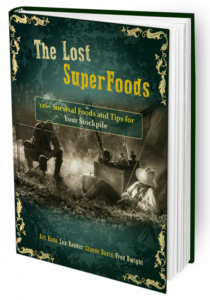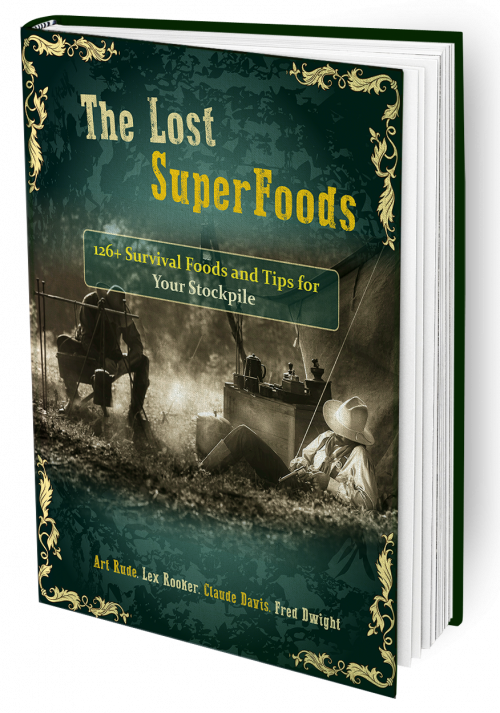What isThe Lost Super Foods Book?
The Lost Super Foods is a guidebook that explores nutrient-dense foods and food preservation techniques inspired by ancient practices and survival strategies. Designed for those interested in preparedness, self-sufficiency, and sustainable living, the book aims to teach readers how to make and store foods that last without refrigeration, while providing maximum nutrition. The recipes and techniques draw from a variety of cultures and historical periods, offering insight into how our ancestors sustained themselves through famines, wars, and times without modern conveniences.

Purpose of The Lost Super Foods
The book is geared toward individuals who want to be prepared for emergencies, such as natural disasters, economic downturns, or food shortages, by having nutrient-rich foods readily available. It provides instructions for creating high-calorie, long-lasting foods that require minimal resources to produce and store. By following the steps outlined in the book, readers can learn how to create their own stockpile of preserved foods that can sustain them over long periods.
Key Features of The Lost Super Foods
- Ancient and Traditional Recipes:
- The book includes recipes that have been used for centuries, such as pemmican (a high-energy meat and fat mixture from Native American traditions) and hardtack (a durable cracker used by sailors). These foods are designed to last without spoilage.
- Long Shelf Life Techniques:
- The guide covers preservation methods that do not require refrigeration, including salting, drying, fermenting, and canning. These techniques help create foods that can last for months or even years.
- Nutrient-Rich Foods:
- Many of the recipes focus on high-calorie, nutrient-dense ingredients, providing essential vitamins, minerals, and energy sources. This makes them ideal for sustenance in times of limited access to fresh food.
- Self-Sufficiency and Survival Preparedness:
- The Lost Super Foods offers advice on how to create a food supply for emergencies, teaching readers how to prepare, store, and rotate foods for a lasting stockpile.
- Culturally Diverse Foods:
- The book draws on recipes and preservation techniques from various cultures around the world, offering a wide range of flavors and ingredients to explore.
- Step-by-Step Instructions:
- With clear, easy-to-follow steps and illustrations, even beginners can start making these superfoods at home without prior knowledge of food preservation.
Types of Foods Covered in The Lost Super Foods
- Dried Meats: Including traditional recipes for jerky and pemmican, which are rich in protein and healthy fats and can last for long periods.
- Hardtack and Crackers: Hard breads that are high in carbohydrates, easy to make, and can be stored for years.
- Preserved Vegetables and Fruits: Techniques for drying and fermenting vegetables and fruits, which help retain nutrients while increasing shelf life.
- High-Calorie Stews and Soups: Recipes for thick, hearty stews that can be preserved or canned, providing a balanced source of protein, fats, and carbohydrates.
- Fermented Foods: Recipes for items like sauerkraut and kimchi that contain beneficial bacteria, supporting digestive health and immunity.
Benefits of The Lost Super Foods
- Emergency Preparedness:
- The book provides readers with the knowledge to prepare for food shortages or emergencies, helping ensure they have access to nutritious food even during crises.
- Reduces Dependency on Refrigeration:
- With techniques that avoid the need for refrigeration, readers can store foods even if they lose power or live in remote areas without reliable electricity.
- Cost-Effective and Sustainable:
- Making and preserving your own foods can reduce grocery bills and food waste, as these methods allow for bulk preparation and long-term storage.
- Promotes Nutrient-Dense Eating:
- Many of the recipes focus on high-calorie, nutrient-dense ingredients, offering a healthier alternative to processed foods often stocked for emergencies.
- Teaches Traditional Skills:
- The book revives traditional food preservation skills, allowing readers to reconnect with ancient practices that supported communities for generations.
- Good for Outdoor and Camping Enthusiasts:
- Many of the recipes, like jerky and dried fruits, are ideal for outdoor adventures, camping, and hiking, as they are lightweight and highly nutritious.
Potential Drawbacks of The Lost Super Foods
- Time-Intensive:
- Some preservation methods, such as drying, fermenting, or canning, require time and patience, as well as the initial effort to learn the techniques.
- Initial Investment in Supplies:
- Some methods may require special equipment, such as canning jars, dehydrators, or fermentation vessels, which could mean an upfront cost for beginners.
- Limited Fresh Foods:
- Since the focus is on long-lasting foods, fresh vegetables, and fruits are not the primary focus, so readers may still need access to fresh produce for a balanced diet.
- Results May Vary:
- Homemade preservation methods may require practice to perfect, and without proper technique, there is a risk of spoilage or reduced shelf life.
- Not a Substitute for Professional Storage Solutions:
- While the book offers valuable methods, it may not fully substitute for professionally packaged emergency foods that are designed for extremely long shelf lives.
Who Should Consider The Lost Super Foods Book?
The Lost Super Foods book is ideal for individuals interested in emergency preparedness, sustainable living, or survivalism. It’s also useful for outdoor enthusiasts, those living off the grid, or anyone wanting to reduce their reliance on commercial foods. Families looking to build a home food stockpile or those exploring traditional preservation methods may also find this guide valuable.
Conclusion
The Lost Super Foods book provides a valuable resource for anyone looking to build a stockpile of nutrient-rich, long-lasting foods. With its focus on ancient preservation techniques and practical recipes, it empowers readers to become more self-sufficient and prepared for potential emergencies. Although it requires some time and resources, the skills and knowledge gained from this guide can offer peace of mind and a sustainable approach to food storage for the future.





